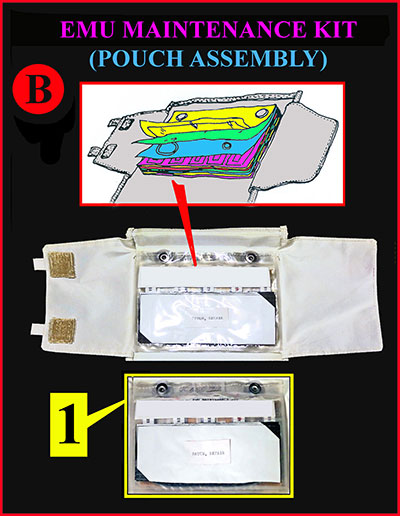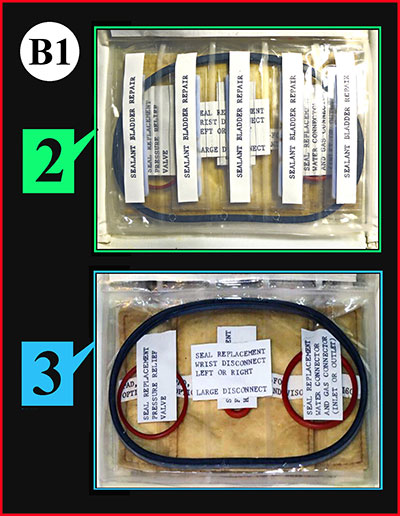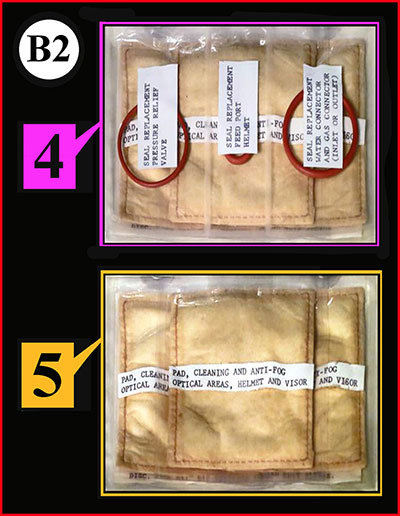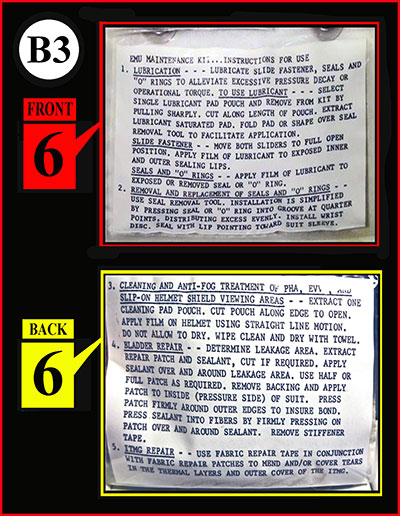|
Author
|
Topic: My personal Apollo story (Dan Schaiewitz)
|
Rick Mulheirn
Member Posts: 4600
From: England
Registered: Feb 2001
|
 posted 11-15-2016 01:18 PM
posted 11-15-2016 01:18 PM
  
Terrific images Dan. Thank you! |
Daniel on the Moon
Member Posts: 354
From: Bronxville, NY
Registered: Jun 2015
|
 posted 11-15-2016 02:04 PM
posted 11-15-2016 02:04 PM
   
You are very welcome Rick. As long as there is continued interest in my posts by cS members like yourself, I will continue to devote my time and effort to provide content that is both interesting and, in my opinion, historically important.
|
Charlie16
Member Posts: 545
From: Italy
Registered: Dec 2010
|
 posted 11-15-2016 05:12 PM
posted 11-15-2016 05:12 PM
   
Thank you Daniel for your effort.
I take care the OPS cover that I showed to Al Worden and that soon will put in the hands of Fred Haise (on any photo you sent me you see Haise with Ops on the shoulders while training for Apollo 16). I think the PLSS and OPS are two of the most important objects for human exploration dellla moon. It's a real privilege to read your reports. |
mikepf
Member Posts: 448
From: San Jose, California, USA
Registered: Mar 2002
|
 posted 11-15-2016 06:32 PM
posted 11-15-2016 06:32 PM
   
Dan, your posts are valuable and informative. I may not comment often, but do read them and always look forward to them. Please keep them coming. |
Daniel on the Moon
Member Posts: 354
From: Bronxville, NY
Registered: Jun 2015
|
 posted 11-16-2016 12:12 AM
posted 11-16-2016 12:12 AM
   
quote:
Originally posted by Charlie16:
Thank you Daniel for your effort.
Luigi, when you see astronaut Haise you may not want to show him the OPS training cover as it might remind him of the PLSS training Cryopacks that he was not too fond of! After Apollo 13 EVA training, Fred said: "Thanks for the PLSS Dan, but no thanks for those 2 ton Cryopacks. I don't care if I never see one of those again!" Also, don't remind him how hot he was training outside on the simulated lunar surface in the Florida heat not only carrying the "2 ton" Cropacks but also without LCG water cooling! |
Daniel on the Moon
Member Posts: 354
From: Bronxville, NY
Registered: Jun 2015
|
 posted 11-16-2016 12:23 AM
posted 11-16-2016 12:23 AM
   
quote:
Originally posted by mikepf:
I may not comment often, but do read them and always look forward to them.
Thank you Mike. We are all in this together. Let's turn up the volume on our built in "mikes" (no pun intended) and continue advocating for the future of space exploration. |
Charlie16
Member Posts: 545
From: Italy
Registered: Dec 2010
|
 posted 11-16-2016 08:19 AM
posted 11-16-2016 08:19 AM
   
Thanks Dan, As we know, Haise, during Apollo 16, was the back-up and this picture shows him with the Ops Cover.  |
Daniel on the Moon
Member Posts: 354
From: Bronxville, NY
Registered: Jun 2015
|
 posted 11-16-2016 11:53 AM
posted 11-16-2016 11:53 AM
   
Yes, Fred is wearing the subject OPS cover in the photo as Apollo 16 backup commander.As you may be aware, if you are following my recent posts, I'm recalling and documenting, as best I can, my experience as PLSS/OPS EVA Crew Training manager. So far I've documented experiences with the PLSS training Cryopacks. When I looked at your posted photo, I noticed Astronaut Haise was wearing another training version of the PLSS that we named the "Air Pack" as it supplied breathable gaseous air to the astronaut through the red hose (in the photo) rather than cryogenic liquid air as I've explained with the Cryopack. You can look forward to future posts that will explain in detail why it was necessary to utilize the Air Pack as well as OTHER training Life Support configurations. |
Nigel Mc
Member Posts: 182
From: Sheffield, UK
Registered: Jan 2011
|
 posted 11-19-2016 05:04 PM
posted 11-19-2016 05:04 PM
   
Dan, this thread is great! Would it be okay to email you to ask a few questions? Thanks! |
Daniel on the Moon
Member Posts: 354
From: Bronxville, NY
Registered: Jun 2015
|
 posted 11-19-2016 06:16 PM
posted 11-19-2016 06:16 PM
   
Yes, of course. |
Daniel on the Moon
Member Posts: 354
From: Bronxville, NY
Registered: Jun 2015
|
 posted 11-21-2016 02:16 AM
posted 11-21-2016 02:16 AM
   
Now that I've described, in my previous posts, the differences between the flight PLSS and the astronaut training cryopacks, let's discuss my concerns and experiences with the cryopacks used by the astronauts during EVA mission training exercises.
When my two HSD techs and myself were provided the information necessary to understand the function and procedural use of the cryopack, it was time to take over the KSC PLSS/OPS EVA crew training operations. In retrospect, I'm not sure if I recognized the significance of the important responsibility that I was given as PLSS/OPS EVA crew training mission(s) manager.As we all know, meeting the deadline set by President Kennedy before the end of the decade, Dec. 31, 1969 to land a man on the moon and bring him back safely, required meeting schedules that seemed unrealistic to many and achievable to some, i.e. schedule deadlines that, at least for me, did not give me time to contemplate the reality of my responsibility to provide reliable hardware (PLSS/OPS) for each and every EVA training exercise for Apollo 11 through Apollo 17, hardware, that would provide the "life sustaining" breathable air, carbon dioxide removal, communications and cooling. I had my challenges, and very real concerns about hardware reliability and future potential problems. My very first concern was that the cryopacks did not come with a "paperwork" trail, meaning that there were absolutely no written procedures to inspect and test the cryopack. Yes, that's exactly what I said!
When I asked for inspection and testing procedures, I was told that they do not exist! I was, as you can well imagine, very concerned, to say the least. Every other "life support" (life support being the operative word) hardware system whether used for flight or training required procedures for periodic testing and inspection, procedures for inspecting hose lines, line fittings, hose nozzles for cracks, nicks, cuts, etc. There were also no requirements for functional testing to confirm that all system and component specifications were met, neither informally or formally with a KSC approved and signed document. The cryopacks did not even have a data package that would have included the inspection, testing, charging, cleaning, malfunction and repair history. Being so involved with testing flight PLSS/OPSs, all I could do was "scratch my head" in disbelief! An example of life support equipment that included the normal requirements for documentation, as I discussed, is the astronaut purge and transfer ventilator that was maintained by the Bendix Corporation at KSC. The ventilator as many of you know, was a handheld unit with a suit inlet and outlet hose connected to the suited astronaut that was used to pre-oxygenate (in a 100% oxygen environment) the astronaut prior to decompression for transfer from the suit room to either chamber tests or transfer to the launch pad via a "transfer van." It is more than interesting to note that the ventilator functionally operated identically to the cryopack. The procedures for testing and inspecting the ventilator were documented in an approved and signed KSC document. That being said, you can look forward to future posts that reflect ramifications of the absence of cryopack procedural testing and inspection requirements. |
Daniel on the Moon
Member Posts: 354
From: Bronxville, NY
Registered: Jun 2015
|
 posted 11-23-2016 12:25 AM
posted 11-23-2016 12:25 AM
   
As I stated in my most recent post, I had very real concerns about cryopack hardware reliability and future potential problems. Those concerns were, in my mind, justified as the cryopacks did not come with the aforementioned "paperwork" trail, meaning that there were absolutely no written procedures to inspect and test the cryopack. The overriding concern for me was the "SAFETY" of the crew during EVA training exercises. Many times, literally, my concerns prevented me from getting a good night's sleep.Not only were the flight PLSSs tested and inspected many times over following very detailed and approved signed procedures, they also provided telemetry to monitor bio-medical and PLSS performance data and included a built in out of spec alert system, i.e. audio alarms and remote control unit visual alerts that prompted the crew member to implement practiced emergency procedures. Knowing that potential reliability problems existed along with the inability to monitor astronaut EKG and cryopack real time functional performance, I tried my best to implement astronaut EVA "work around" monitoring procedures that first and foremost addressed the "SAFETY" of the crew. Our cryopack training briefing was based on monitoring procedures used at MSC. As we discovered, there were no formal crew "SAFETY" procedures. As I became more familiar with the PLSS training cryopacks after supporting several crew training exercises, I was able to generate astronaut safety procedures based on "what I had to work with!" I subsequently incorporated my written procedures in a document appropriately titled "Procedures For Testing The Astronaut Training Cryogenic Life Support Back Pack," KSC Procedure NO: CTE-H-3001/KL-9650. This, in fact, was the inspection and testing procedural document that did not exist, a document that should have been written before the cryopacks were approved for astronaut life support. Before I discuss the astronaut crew training EVA "SAFETY" procedures I wrote, it is necessary to define specific cryopack components that are identified in the subject procedures. In cryopack photo #1 (below), I've identified Suit Pressure Gauge "A," System Pressure Gauge "B," Suit Pressure Control Knob "C" and Vent Valve "D." 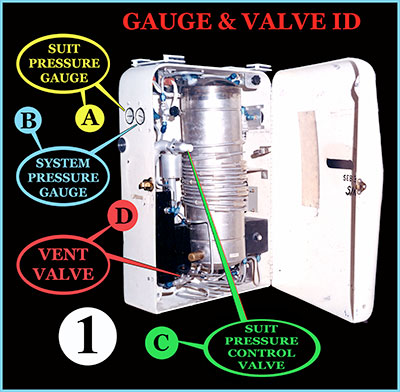 |
Daniel on the Moon
Member Posts: 354
From: Bronxville, NY
Registered: Jun 2015
|
 posted 11-23-2016 12:38 AM
posted 11-23-2016 12:38 AM
   
In photo #2, my cryopack tech is turning the suit pressure control valve knob "C" clockwise to increase suit pressure to 3.75 psi. An enlargement of suit pressure gauge "A" shows that it does in fact read 3.75 psi. The enlargement is a little "blurry." I'm sorry for that but it was the best I could do. System pressure gauge "B" shown enlarged, reflects a system pressure of 160 psi (again, a little blurry) which is the nominal cryopack system pressure reading after a full Liquid Air charge.In case of either a suit pressure emergency (low or high) or a system pressure emergency (low or high) the hinged cryopack door permitted easy access to both the suit pressure control valve "C" and vent valve "D." These were the valves that were referred to be used in my safety procedures to follow. 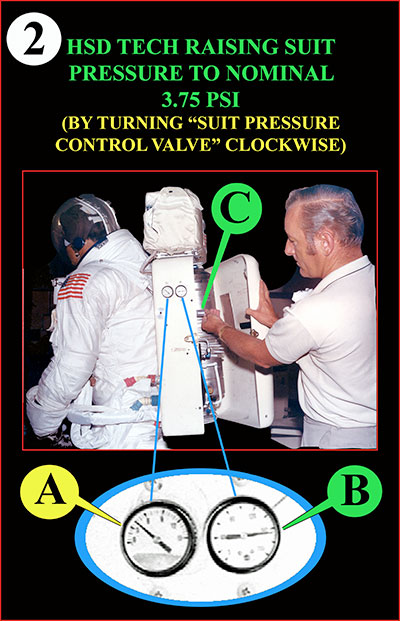 Following are the safety procedures that I wrote and implemented: 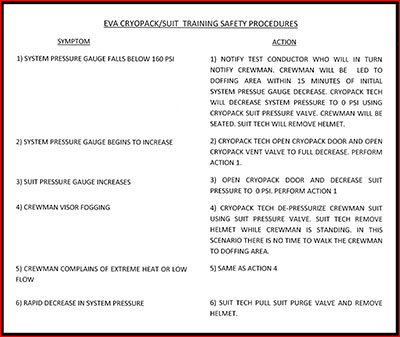 |
Apolloman
Member Posts: 233
From: Ledignan, Gard (30), France
Registered: Mar 2009
|
 posted 11-23-2016 01:21 AM
posted 11-23-2016 01:21 AM
   
Thank you Dan for sharing your experiences with us. You are a wealth of information on A7L suit and their systems and a good pedagogue. |
Daniel on the Moon
Member Posts: 354
From: Bronxville, NY
Registered: Jun 2015
|
 posted 11-23-2016 01:23 AM
posted 11-23-2016 01:23 AM
   
Photo #3 reflects the ideal astronaut safety monitoring "situation", i.e. the cryopack suit pressure and system pressure gauges are visible (not blocked as I will explain later) and astronaut helmets are visible (not blocked by UV visors). These conditions are necessary to implement the symptom/action procedures (above).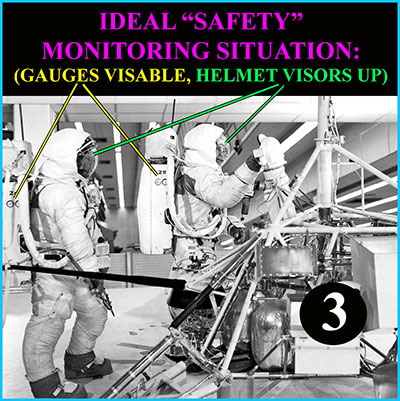 In photo #4, astronaut UV visors are engaged covering the helmet preventing awareness of Symptom #4 (visor fogging) and preventing Action #4 implementation. 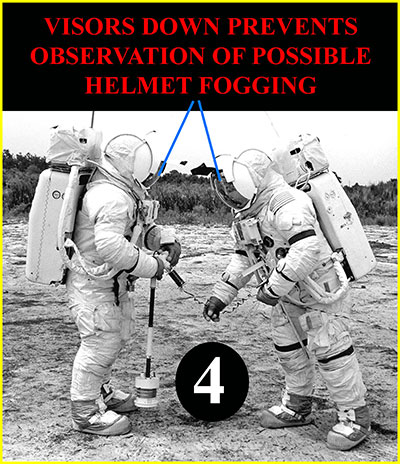 In photo #5, Apollo 13 LMP Haise's UV visor is not completely covering his helmet. With the UV visor partially up, there is room to "peek" in to see if his helmet was fogging, i.e. Symptom #4 in Safety Procedures. 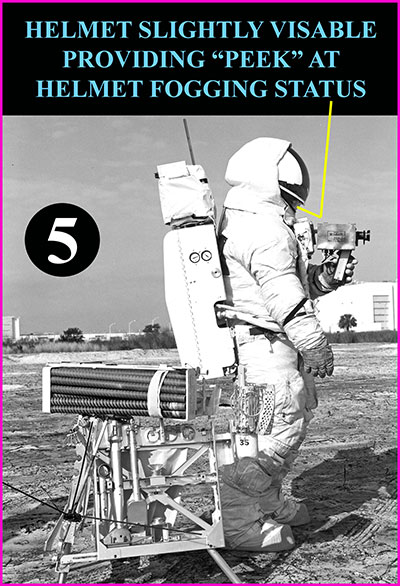 |
Daniel on the Moon
Member Posts: 354
From: Bronxville, NY
Registered: Jun 2015
|
 posted 11-23-2016 01:48 AM
posted 11-23-2016 01:48 AM
   
The photo #6 scenario represented a very dangerous "SAFETY" situation. As you can see, not only are the Apollo 17 astronauts Cernan and Schmitt's UV visors "A" down, but the suit pressure and system pressure gauges are covered by a tool holder "B" on one side and a sample bag "C" on the other side (both sides of the cryopack had duplicate gauges).Communication capability with the astronauts via the portable ground stations was the last "lifeline" remaining to monitor the physiological condition of the crew. We were very cognizant of this situation and I met with each EVA training mission test conductor before the first training exercise for that mission. I discussed my "SAFETY" procedures and in the case of the photo #6 scenario (visors down, gauges blocked), I suggested and they all agreed they would ask the crew if they were okay about every ten (10) minutes. It was agreed that I would keep track of the time and would signal the test conductor by pointing to the crew when I knew I had the attention of the test conductor. 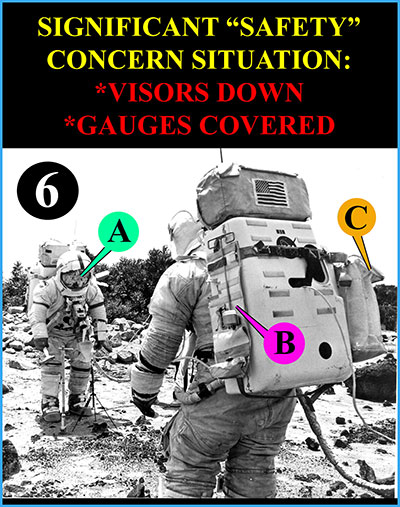 |
Apolloman
Member Posts: 233
From: Ledignan, Gard (30), France
Registered: Mar 2009
|
 posted 11-23-2016 01:52 AM
posted 11-23-2016 01:52 AM
   
Dan, what is the black box (communication system?) on the PLSS door on this picture? |
Daniel on the Moon
Member Posts: 354
From: Bronxville, NY
Registered: Jun 2015
|
 posted 11-23-2016 01:59 AM
posted 11-23-2016 01:59 AM
   
With the crew on the rover (as in photo #7), an additional challenge was walking and sometimes running to keep up with the rover to monitor gauges (if not covered) and helmet fogging (if not covered). Additionally, while "chasing" the rover we carried the "not so light" ground station communications unit "A" (photo #7).In photo #7, the rover is not moving and it appears that I'm trying to catch my breath after running and carrying the ground station. 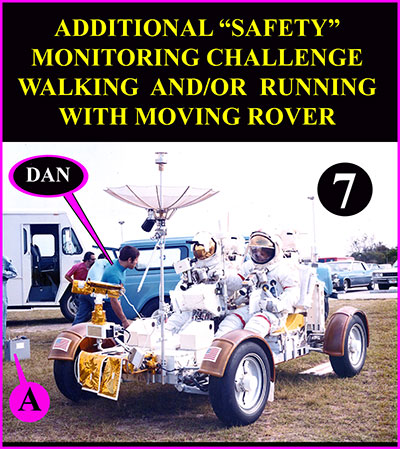 |
Daniel on the Moon
Member Posts: 354
From: Bronxville, NY
Registered: Jun 2015
|
 posted 11-23-2016 02:56 AM
posted 11-23-2016 02:56 AM
   
quote:
Originally posted by Apolloman:
Dan, what is the black box (communication system?) on the PLSS door on this picture?
You are looking at one of the first versions of the cryopack used at MSC. This was before we received our cryopack "version" at the KSC.The black box is, in fact, a communications unit that was used before it was decided that the version in the photo did not function as expected. The cryopacks that we used at KSC relied on the flight PLSS unit made by RCA. What you are looking at is a communications unit that had two connectors. One connector went to the PGA comm connector in turn connected to the astronaut "snoopy" head set. The second connector went to an external battery that was sometimes hooked on to the slot on the cryopack door and sometimes carried by a suit tech following the astronaut. You can see the thinner black cable fed through a hole in the door. The RCA communications that we ended up using at KSC, if you recall from my drawings, had four connectors. The other two respectively connected to the OPS antenna rather that an internal antenna in the unit you were looking at and the fourth connector on the RCA unit connected to the RCU used in training to turn the unit on (push to talk toggle and to place the mode selector switch to the duel mode). The subject unit that you see was turned on by connecting to the battery and only had one mode. |
Apolloman
Member Posts: 233
From: Ledignan, Gard (30), France
Registered: Mar 2009
|
 posted 11-23-2016 05:19 AM
posted 11-23-2016 05:19 AM
   
Thank for your answer Dan. |
NJ CO
Member Posts: 23
From: Greenwich, NJ, US
Registered: Mar 2008
|
 posted 11-24-2016 11:40 AM
posted 11-24-2016 11:40 AM
  
Just another thanks, Dan. I'm always amazed of the extraordinary details you can recall and explain them here to the nth degree in a way that folks like myself can easily understand. |
Daniel on the Moon
Member Posts: 354
From: Bronxville, NY
Registered: Jun 2015
|
 posted 11-28-2016 12:21 AM
posted 11-28-2016 12:21 AM
   
I prepared for a scheduled crew training EVA exercise at Kennedy Space Center as follows: - At 9:00 a.m., one day before the scheduled exercise I called the KSC Crew Systems Division (CSD) EVA Test Conductor to confirm that the exercise was a "go."
- If the test was on, I called the Bendix Corporation located at KSC Hanger S to schedule four cryopacks to be charged (filled) with liquid air the day before the scheduled exercise.
- The four cryopacks were loaded into the HSD government issued Dodge van and were transported to Bendix.
- The charged cryopacks were picked up from Bendix at 8 a.m. the next day (morning of the scheduled exercise) and brought back to the HSD building. They remained in the van until it was time to drive to the KSC Crew Training Building in time for the scheduled exercise.
The crew donned their suits with help of ILC (suit) and HSD (cryopack) techs. After checking voice communications, cryopack pressure was increased to a nominal 160 psi. Suit pressure was then set at 3.7 psi.EVA training exercises were scheduled to last from one to 2.5 hours. The designed nominal cryopack operational time was 1.5 hrs. With two available charged cryopacks for each crewman, a nominal combined cryopack operational time of three hours was possible with a half hour to spare. This was the criteria I used for setting up and managing the KSC EVA training program. As we've all experienced, things don't always work as designed and planned. The cryopacks were no exception. One of my first negative experiences occurred during an indoor EVA exercise with Apollo 12 LMP Al Bean. About 25 minutes after the beginning of the "run" (exercise) one of my two HSD techs came over to me and said that astronaut Bean's cryopack pressure was slowly decreasing from the nominal 160 psi operating pressure. I notified the test conductor. As per the "EVA Cryopack/Suit Training Safety Procedures" that I authored (outlined in a previous post), the crewman had no more than 15 minutes of breathable air remaining. The test conductor asked if he could have about five minutes to complete the deployment of the Solar Wind Spectrometer (seen in the below photo). I said yes to the test conductor and when the deployment task was completed, my HSD tech (per the Symptom/Action Safety Procedures) decreased the system pressure to 0 psi. Astronaut Bean was led to his suit donning/doffing chair, suit pressure was reduced to 0 psi and Al's helmet was removed. For those of you that have a sense of humor, I thought it would be amusing to compare the Solar Wind Experiment to R2D2 (below photo). To continue the exercise, the second cryopack was secured to crewman Bean and the exercise continued as if "nothing happened!" Picture the following scenario. Knowing that the first cryopack operated for 25 minutes, knowing that the replacemet second cryopack theoretically had 1.5 hours of normal operation and knowing the total test time (test conductor's estimate) was two hours and 15 minutes we had a problem. Even if the replacement cryopack lasted 1.5 hours (of course, after what happened with the first unit, I had my doubts), we were short 20 minutes. I tried not to panic. I calmly went to the wall phone (below photo) and called Bendix saying we had an "emergency" situation that required charging a cryopack. My Bendix contact was very cooperative and asked what he could do. I said I was sending my tech Ray with the cryopack to him to be immediately charged so it could be returned to the Crew Training Building within one hour. I left myself a 15 minute buffer as the exercise had already run 15 minutes before my tech left the building and headed for the Bendix facility. I was mentally in "panic mode" but I tried not to show it. I prayed that the replacement cryopack would last for the expected 1.5 hours and that my tech would return within the planned hour. I called Bendix twice for a status update. My primary concern was for HSD to not be responsible for shutting down a crew training exercise before all objectives were completed.
About a minute before my remaining HSD tech (we always had two) notified me that the system pressure of the cryopack in use began to decrease, in walked my tech Ray carrying the recharged pack with very little time to spare. Bottom line, the exercise was successfully completed. The fact that the run might have been cut short, was known only by three individuals, i.e. me and my two HSD techs! And that's the "rest of the story!" 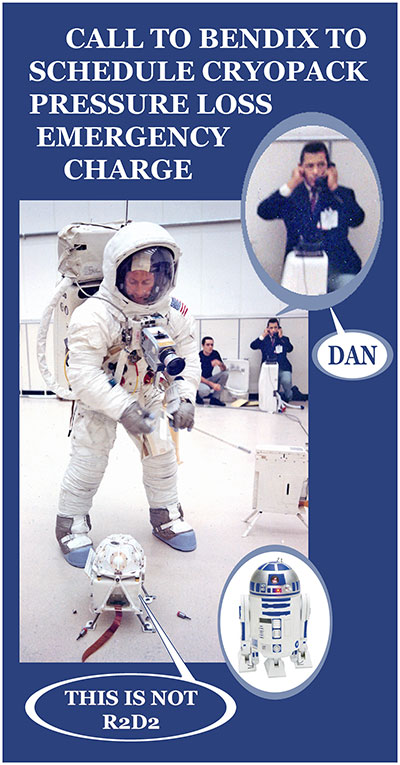 |
Wehaveliftoff
Member Posts: 2343
From:
Registered: Aug 2001
|
 posted 11-30-2016 09:01 PM
posted 11-30-2016 09:01 PM
  
"R2D2, you know better than to trust a strange computer" (The Empire Strikes Back) |
MCroft04
Member Posts: 1861
From: Smithfield, Me, USA
Registered: Mar 2005
|
 posted 12-01-2016 07:16 PM
posted 12-01-2016 07:16 PM
   
Dan, were you able to determine why Bean's first cryopack failed? On future training exercises did you schedule more than four cryopacks?Surely Bean knew the difference between the training and flight articles, but did he express any concerns about this problem occurring while on the moon? I understand the flight article was completely different, but.... |
Daniel on the Moon
Member Posts: 354
From: Bronxville, NY
Registered: Jun 2015
|
 posted 12-02-2016 02:14 AM
posted 12-02-2016 02:14 AM
   
The short answer to your question with respect to determining the reason Bean's cryopack "failed" is yes.We found that the cryopack leaked a significant amount of air between the time it was filled during a Bendix second shift at about 8 p.m. the evening before the scheduled exercise and the beginning of the crew training exercise the following day at 2PM. The cryopacks were designed to hold their full charge for a minimum of 16 hours with very minimal subsequent hourly leakage. The answer to your question "Did we schedule more than four cryopacks" is a resounding "yes." Fortunately we had a total of six units with two that I designated as non-charged backups, until after we experienced the problem. The leakage problem turned out to be an inherent design flaw that required future modifications at MSC. We were not able to send the cryopacks to MSC until after Apollo 13 EVA training was completed when we received two additional cryopacks from MSC with the same leakage problems! (I plan to tell the whole story in detail in future posts.) With the two additional cryopacks giving us a total of eight units, we were able to send two cryopacks to MSC for modification. When the "modified" cryopacks were returned to KSC we sent two more, etc. I plan to include the detailed story of all the decisions I made as a result of continuing cryopack problems. I will say, and I am very proud to say that despite all the problems, we never missed a crew training exercise nor did we have to cut a run short. As you mentioned, the astronauts recognized that they were not training with flight hardware, however, they, nor the test conductor were concerned as we were always able to switch out packs when there were problems. Also, as I will discuss in future posts, I coordinated the use of substitute "air packs" that were connected by a long hose to an air supply both inside and outside when conditions were warranted. To complicate matters further, I had to design a method to water cool the crew using their liquid cooling garments (LCG) because, believe it or not the cryopacks provided air cooling only. When astronaut metabolic heat loads were high and/or the temperature outside was high (Florida gets hot!), cryogenic liquid air converted to gas cooling did not "cut it!" When the Apollo 13 astronauts finally made the lack of sufficient cooling an issue (as stated in the Apollo 13 Final Report), I was determined to provide a solution. |
Charlie16
Member Posts: 545
From: Italy
Registered: Dec 2010
|
 posted 12-02-2016 04:54 AM
posted 12-02-2016 04:54 AM
   
Thank you Dan for your effort. |
Daniel on the Moon
Member Posts: 354
From: Bronxville, NY
Registered: Jun 2015
|
 posted 12-02-2016 12:23 PM
posted 12-02-2016 12:23 PM
   
As I've stated in previous posts, one of my remaining life goals is to provide as much detailed information about my first hand experiences at KSC to help future historians enhance their perspective about how we landed a man on the moon with the technology available in the year 1969!My most important goal is to inspire youth around the world to pursue a future in the exploration of the universe. Thank you for your dedication to preserve the legacy of space exploration with your incredible museum. |
LM-12
Member Posts: 4021
From: Ontario, Canada
Registered: Oct 2010
|
 posted 12-02-2016 01:21 PM
posted 12-02-2016 01:21 PM
  
Dan, are you familiar with the "Apollo Experience Report" series of documents? There must be over a hundred such MSC documents in the series covering many aspects of the Apollo program. Here is the 1975 EMU document.Not sure if there was ever an "Apollo Experience Report" about the EVA crew training at KSC, but with your knowledge and experience, you certainly would be the person to author such a document. |
Daniel on the Moon
Member Posts: 354
From: Bronxville, NY
Registered: Jun 2015
|
 posted 12-02-2016 06:55 PM
posted 12-02-2016 06:55 PM
   
I am familiar with the Apollo Experience Reports. You are correct in assuming that very little had been written about EVA Crew Training until I began documenting and will continue to document my crew training recollections. |
Daniel on the Moon
Member Posts: 354
From: Bronxville, NY
Registered: Jun 2015
|
 posted 12-03-2016 01:05 AM
posted 12-03-2016 01:05 AM
   
Looking back, as I often do, I'm as much in awe of Apollo program achievements now as I was almost 50 years ago. This, despite the fact that I was so intimately involved in the "nuts and bolts" details and logistics essential for mission success.There was so much creative thinking that lead to so many problem solutions that no one but those intimately involved are aware of. I was recently looking at a photo of myself (below) where I appeared to be reading or as my wife said it looked like I was praying. No, in fact, I was evaluating, commenting on, and proposing changes to procedures for using the astronaut EMU maintenance kit. The maintenance kit was one of those "unsung" unused Apollo EMU components that, in my opinion, was one the of the most "creative packaging concepts" and an excellent example of the creative thinking that helped us achieve mission goals. I want to share with you the functional details and creative packaging of this amazing EMU component that I was fortunate enough to have worked with as follows: The EMU maintenance kit contained cleaning, replacement and repair parts including supplies for in flight maintenance of the Apollo Pressure Garment Assembly (PGA) and the Extra-Vehicular Visor Assembly (EVVA). The EMU maintenance kit graphic below illustrates three photos of the maintenance kit, i.e. closed, partially open and fully open. The photo in the graphic is me (Dan) evaluating procedural use changes that were made to the kit based on previous astronaut feedback. After my evaluation and consensus approval, the changes were ready for the astronauts to re-evaluate and comment on. 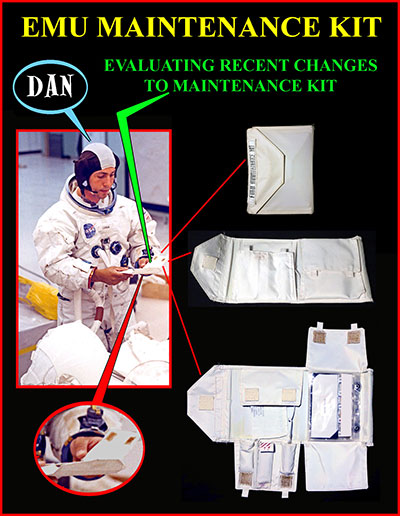 The EMU maintenance kit consisted of two primary sections. First is the pocket assembly (Figure A below). The pocket assembly, held closed by hook and pile fastener strips, folded out to reveal four pockets containing items labeled 8, 9, 10 and 11 as follows: - FABRIC REPAIR TAPE (8)
The Fabric Repair Tape was made of fiber glass and was cut in two lengths (1"x 36") wrapped individually to a nylon rod. A Beta cord lanyard connected a strip of Velcro (hook) to the rod. The tape was stowed in the pocket seen in Figure A.The Fabric Repair Tape was intended to be used to complete small repairs to layers of the Integrated Thermal Micro-Meteoroid Garment (ITMG) and Cover Layer Assembly (CLA) or used in conjunction with a Teflon coated Beta cloth patch (9 in Figure A) when repairs to abraded, cut, or torn areas of the ITMG or CLA were required. - BETA CLOTH REPAIR PATCHES (9)
Two 5" x 5" squares of Beta cloth were available to be used to repair abraded, cut, or torn areas of the ITMG or CLA. The two patches were "rolled up" and stowed in the pocket seen in Figure A. - LUBRICANT PADS (10)
Eight oil saturated pads were included to be used to lubricate pressure sealing slide fasteners, seals and "O" rings.The pads were stowed in the pocket seen in Figure A. - SEAL REMOVAL TOOL (11)
The Seal Removal Tool is a nylon rod with an angled preformed tip which facilitates the removal of "O" ring seals for replacement in the PGA Wrist Disconnect, Pressure Relief Valve, Helmet Feed Port, Oxygen connectors and LCG water connector.A lanyard with a Velcro (pile) fastener strip is attached to the tool. Temporary stowage is accomplished by engaging the pile strip with any Velcro (hook) strip. The tool was stowed in the pocket seen in Figure A.
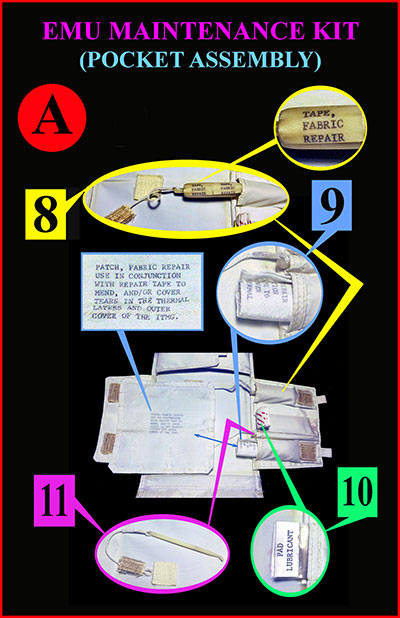 |
Daniel on the Moon
Member Posts: 354
From: Bronxville, NY
Registered: Jun 2015
|
 posted 12-03-2016 01:36 AM
posted 12-03-2016 01:36 AM
   
The second primary section of the EMU maintenance kit is the pouch assembly (Figure B below). The pouch assembly consisted of six transparent, heat-sealed pouches. The contents of each pouch were clearly labeled. The six pouches were attached using snap fasteners.The six pouches and their contents are as follows: |
Apolloman
Member Posts: 233
From: Ledignan, Gard (30), France
Registered: Mar 2009
|
 posted 12-03-2016 02:30 AM
posted 12-03-2016 02:30 AM
   
Yes. The complement of information (for my french website) that I missed. Many thanks Dan. |
Jurg Bolli
Member Posts: 1243
From: Albuquerque, NM
Registered: Nov 2000
|
 posted 12-03-2016 08:54 AM
posted 12-03-2016 08:54 AM
   
Great information, thanks. |
LM-12
Member Posts: 4021
From: Ontario, Canada
Registered: Oct 2010
|
 posted 08-24-2017 01:09 PM
posted 08-24-2017 01:09 PM
  
quote:
Originally posted by Daniel on the Moon:
Therefore, I have to conclude that Cernan is still our subject.
Retro Space Images today posted this Apollo 14 training photo that shows Dan and a suited Gene Cernan with the tear in the bottom red stripe of his suit flag that matches the tear in the Lovell-signed gag photo. |
Daniel on the Moon
Member Posts: 354
From: Bronxville, NY
Registered: Jun 2015
|
 posted 09-15-2017 11:19 PM
posted 09-15-2017 11:19 PM
   
Sixty years (60) ago this month (September, 1957) I presented my ninth grade Science Notebook Project to my Science teacher Mr. Pratt about two weeks before the successful Sputnik launch on October 4, 1957. I was 14 years old at the time (Graphic 1 below).The very first section of the notebook was titled "Exploring Space" (Graphic 2). Included in this section were answers to questions, i.e. "Reasons For Space Travel", "What will we find in Space", "Problems of Space Travel" and other space travel related questions (Graphic 3). In Graphic 4, "Anatomy Of The First US Satellite", I drew my interpretation of the Vanguard 1 Satellite that would have been the first US orbital Satellite if it was not for a launch failure on December 6, 1957. When I wrote about the Vanguard, neither I nor anyone in the scientific community were aware that the Soviet Union was about to launch Sputnik. I cannot speak for the rest of the world at the time but I was totally devastated as I was and had been a "space fanatic" since the age of ten. My evolving interest in space travel began when I discovered and began religiously watching the TV series "Captain Video and his Video Rangers" in 1953. When the "Flash Gordon" TV series came on air in October of 1954 I had two Space Related TV series to inspire my desire to someday be involved in Space Exploration. The devastating feeling after Sputnik turned into cautious optimism when the US successful launched its first Satellite, Explorer 1 on January 31, 1958. From that point on my dream was kept alive by the incredible U.S. space program successes and the rest is history! 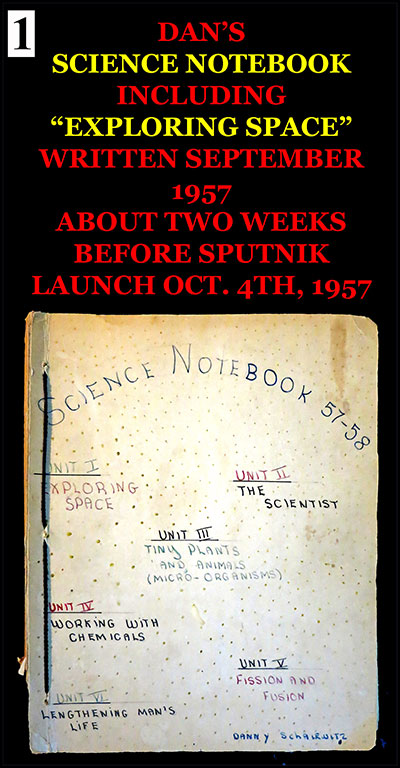 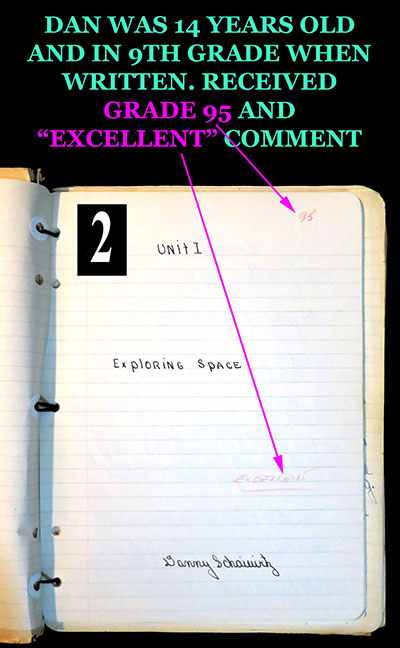
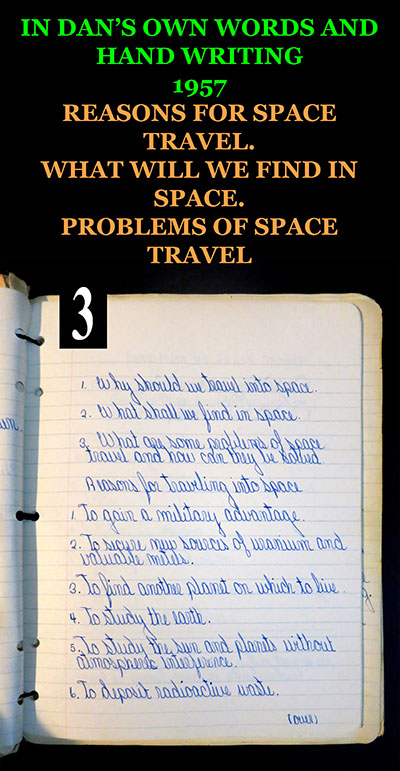
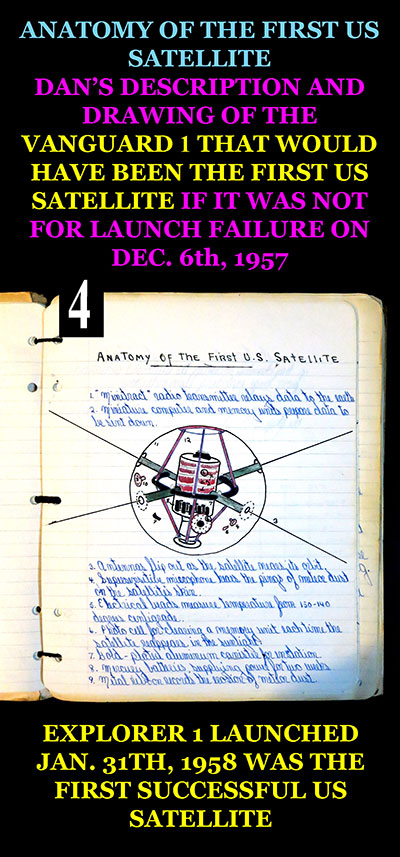
|
MCroft04
Member Posts: 1861
From: Smithfield, Me, USA
Registered: Mar 2005
|
 posted 09-16-2017 07:53 AM
posted 09-16-2017 07:53 AM
   
It's incredible that a 14 year old had the foresight to write such a paper, and even more incredible that you still have it. Yes that definitely makes you a space fanatic. Thanks for sharing! |
Kite
Member Posts: 1163
From: Northampton UK
Registered: Nov 2009
|
 posted 09-16-2017 03:44 PM
posted 09-16-2017 03:44 PM
  
Yes really incredible. So pleased to hear from you again Dan, always interested in the details of your fabulous time in the space programme. |
davidcwagner
Member Posts: 1066
From: Albuquerque, New Mexico
Registered: Jan 2003
|
 posted 09-16-2017 04:22 PM
posted 09-16-2017 04:22 PM
   
Dan, are you left handed? I believe the proportion of left handed astronauts exceeds the general population proportion of left handed men. |
Daniel on the Moon
Member Posts: 354
From: Bronxville, NY
Registered: Jun 2015
|
 posted 09-16-2017 08:35 PM
posted 09-16-2017 08:35 PM
   
Actually, I'm right handed. I no longer have a left handed slant. My handwriting is now very close to perfectly horizontal. Interesting info about left handed astronauts. |
Daniel on the Moon
Member Posts: 354
From: Bronxville, NY
Registered: Jun 2015
|
 posted 09-17-2017 11:05 PM
posted 09-17-2017 11:05 PM
   
When reviewing my Apollo log books from Kennedy Space Center, I found a few of the many specific references to Apollo 11 astronauts Armstrong and Aldrin. Any and all references to Armstrong and Aldrin bring back incredible memories.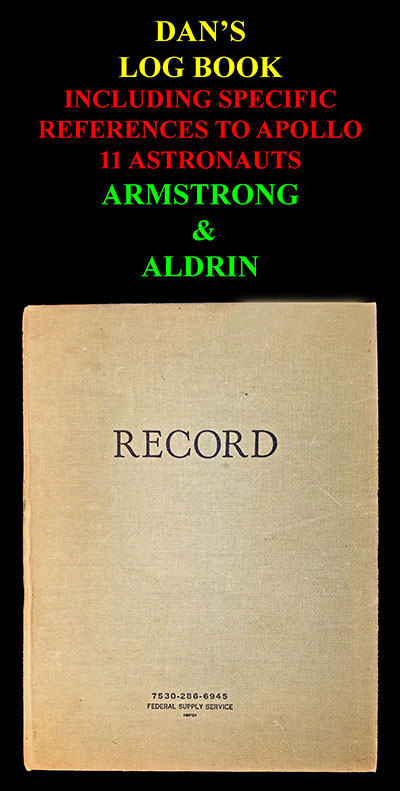 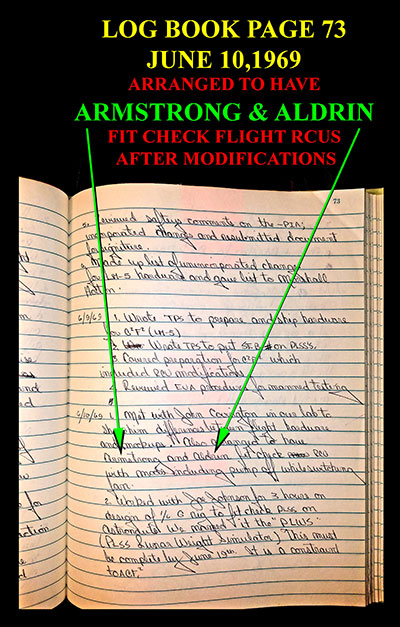
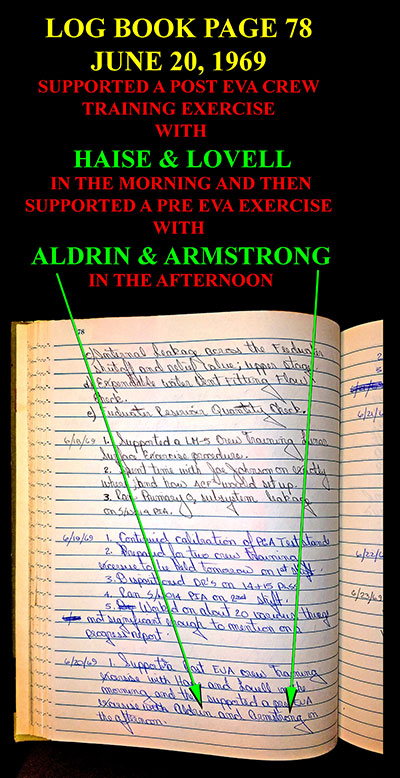
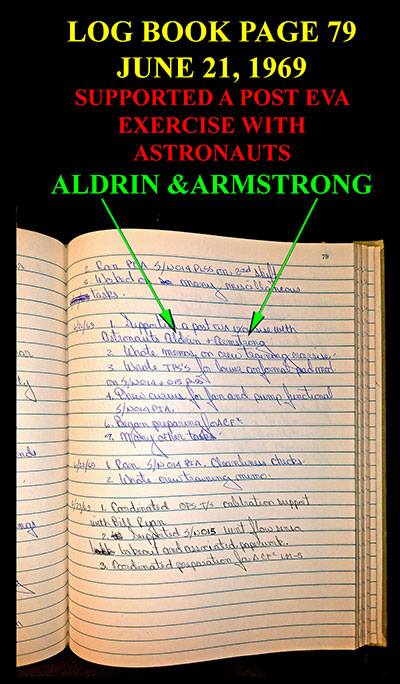
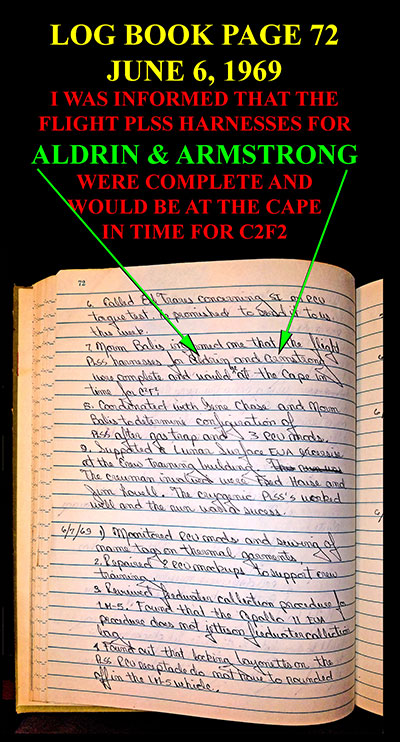
|
























